Book contents
- Frontmatter
- Contents
- List of Figures
- Notes on Contributors
- Acknowledgements
- Foreword: Fostering Recognition under the Luxury of Amnesia
- Chapter 1 An Introduction to Scotland’s Transnational Heritage: Sites, Things and Time(s)
- Part I Transnational Sites
- Part II Transnational Things
- Part III Transnational Time(s)
- Afterword: Building Solidarity: Moving Towards the Repatriation of the House of Ni’isjoohl Totem Pole
- Index
Chapter 7 - The Matter of Slavery at National Museums Scotland
Published online by Cambridge University Press: 25 October 2023
- Frontmatter
- Contents
- List of Figures
- Notes on Contributors
- Acknowledgements
- Foreword: Fostering Recognition under the Luxury of Amnesia
- Chapter 1 An Introduction to Scotland’s Transnational Heritage: Sites, Things and Time(s)
- Part I Transnational Sites
- Part II Transnational Things
- Part III Transnational Time(s)
- Afterword: Building Solidarity: Moving Towards the Repatriation of the House of Ni’isjoohl Totem Pole
- Index
Summary
In the ‘Industry and Empire’ gallery of the National Museum of Scotland (NMS) in Edinburgh sits a gleaming cup of white porcelain, resting on its saucer. Text rendered in black lettering around the body of the cup reads: ‘and so it was that those long sea/journeys became yonder awa awa’. The cup is surrounded by other pieces of the tea set to which it belongs: two cups and saucers, a plate and teapot, each carrying a gilded ship motif (Figure 7.1). At first glance they sit comfortably beside other objects in the case – ceramics, silverware, coins and print material – all from the nineteenth century. But on closer inspection, the crisp minimalism of the cup’s design, the unmistakeably digital typeface, and the contemporary logo appear conspicuous. And just so, for it is indeed the oddity. The cup dates to 2014, not to 1814 or even 1914 like the rest of the material in this case and throughout this gallery. The words were written by poet Malika Booker, as a comment on Scotland’s slavery past being denied and reframed as something that happened elsewhere, and printed for use in The Empire Café, a temporary space set up during the 2014 Commonwealth Games in Glasgow. Visitors could enjoy the delights of tea, coffee and sugary treats while ‘remembering’ how these products – particularly sugar – were at the heart of the Transatlantic Slave Trade which shaped the Scotland we know today.
In 2018 this tea set went on display at NMS, placed among historical objects representing the development of connections between Scotland and the Americas during the period from 1800 to 1914. In museum speak, this was a ‘critical intervention’ in a permanent gallery; an experiment where a contemporary object was mobilised in an attempt to disrupt the narrative and reframe existing collections as a way of highlighting an absence in Scotland’s national story, and to correspond to a recent shift in what we know and how we think about the Scottish past. There is now an established and growing literature about how the slavery system was core to the development of Scotland’s economy from the eighteenth century.
- Type
- Chapter
- Information
- Scotland's Transnational HeritageLegacies of Empire and Slavery, pp. 104 - 119Publisher: Edinburgh University PressPrint publication year: 2023



